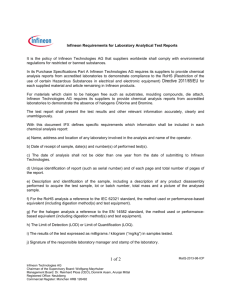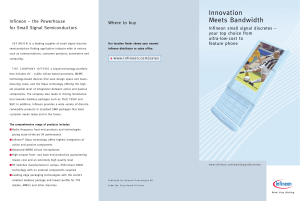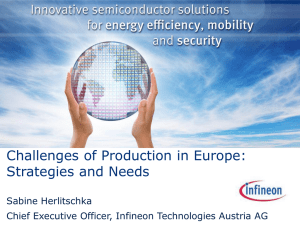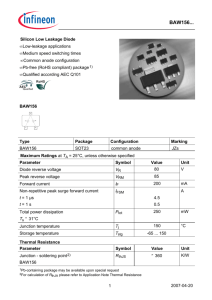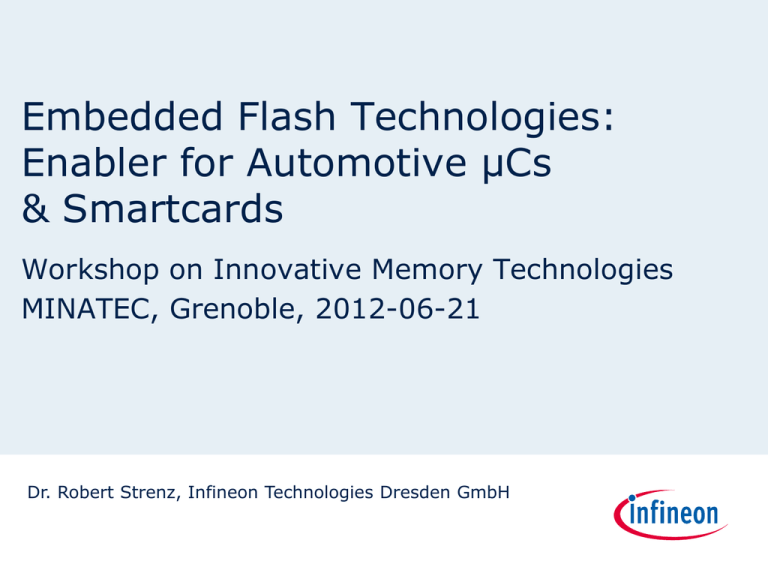
Embedded Flash Technologies:
Enabler for Automotive µCs
& Smartcards
Workshop on Innovative Memory Technologies
MINATEC, Grenoble, 2012-06-21
Dr. Robert Strenz, Infineon Technologies Dresden GmbH
Infineon eNVM Design & Technology Team
Special thanks to
Robert Allinger, Thomas Kern, Klaus Knobloch,
Wolfram Langheinrich, Patrick Leteinturier,
Robert Wiesner and Georg Tempel
Workshop on Innovative Memory Technologies, MINATEC, Grenoble, 2012-06-21
Copyright © Infineon Technologies 2012. All rights reserved.
Page 2
Market & Applications
Technology Requirements
Cell Concepts
Outlook
Set date
Workshop on Innovative Memory Technologies, MINATEC, Grenoble, 2012-06-21
Copyright © Infineon Technologies 2012. All rights reserved.
Page 3
Market & Applications
Technology Requirements
Cell Concepts
Outlook
Set date
Workshop on Innovative Memory Technologies, MINATEC, Grenoble, 2012-06-21
Copyright © Infineon Technologies 2012. All rights reserved.
Page 4
Embedded Flash ICs
IC with on-chip embedded flash
memory
Mostly used for µC products
Typically …
… compatible with bulk CMOS
technology
Example: Infineon µC TC1784 , 90nm
(180 MHz, 2.5 MByte Flash)
… embedded with SRAM, ROM &
Mixed Signal IP
Workshop on Innovative Memory Technologies, MINATEC, Grenoble, 2012-06-21
Copyright © Infineon Technologies 2012. All rights reserved.
Page 5
Why Embedded ?
Cost of Flash-integration (SoC) vs. 2-chip solution (SiP)*
¬ Cost ratio SoC vs. SiP is key & depends on many parameters:
SiP technology
Die size
NVM/Logic area ratio
Number of required connections vs. chip geometry
Interface speed requirements
Voltage compatibility of frontend technologies to combine
Production volume vs. cost of embedded NVM dev’t
¬ For a broadband eFlash IDM today it’s very difficult to find SiP
solutions that serve the whole product portfolio
¬ SiP is and will be an addition to SoC, not a replacement
Performance: direct code execution from embedded flash
Security (Smartcards)
Application-inherent for some products
(e.g. Flash-based FPGAs)
*see also (1) A. Maurelli et al.
Workshop on Innovative Memory Technologies, MINATEC, Grenoble, 2012-06-21
Copyright © Infineon Technologies 2012. All rights reserved.
Page 6
Embedded Flash Applications
Automotive µCs ~4B$ Market
Smartcards ~ 2B$ Market
Consumer & Industrial Applications
Wide variety of applications, no reliable market data available
Workshop on Innovative Memory Technologies, MINATEC, Grenoble, 2012-06-21
Copyright © Infineon Technologies 2012. All rights reserved.
Page 7
Automotive µC & Smartcard Market
Workshop on Innovative Memory Technologies, MINATEC, Grenoble, 2012-06-21
Copyright © Infineon Technologies 2012. All rights reserved.
Data source:
iSuppli Q1 2012 update
Page 8
Market & Applications
Technology Requirements
Cell Concepts
Outlook
Workshop on Innovative Memory Technologies, MINATEC, Grenoble, 2012-06-21
Copyright © Infineon Technologies 2012. All rights reserved.
Page 9
Key Technology Requirements for ATV µCs
Product
Technology
Direct code execution,
access times < 10…20ns
High reading current of code
memory (typically >20µA)
Frequent updates of data
memory (e.g. start/stop
system)
Data-Memory w/ high
endurance & retention lifetime
(500k cycles + full operational
lifetime)
Under hood applications
(e.g. engine & gear shift
control)
Broad Temperature Range
(Tj = -40°C … 175°C)
Safety critical applications
Ultra-low fail rates < 1ppm
Workshop on Innovative Memory Technologies, MINATEC, Grenoble, 2012-06-21
Copyright © Infineon Technologies 2012. All rights reserved.
Page 10
Key Technology Requirements for
Smartcards
Product
Technology
Fast prog & erase w/ small
data granularity (e.g. GSM
cards)
Short erase time (< 5ms)
w/ page or smaller granularity
Frequent data update (e.g.
change of encryption keys for
Pay-TV)
High write/erase endurance
(>200k cycles)
Good retention after cycling
(M2M products)
Typical application profile:
5y retention after 100k cycling
Workshop on Innovative Memory Technologies, MINATEC, Grenoble, 2012-06-21
Copyright © Infineon Technologies 2012. All rights reserved.
Page 11
Market & Applications
Technology Requirements
Cell Concepts
Outlook
Workshop on Innovative Memory Technologies, MINATEC, Grenoble, 2012-06-21
Copyright © Infineon Technologies 2012. All rights reserved.
Page 12
Mainstream eFlash Concepts
1T-NOR
Splitgate
2T-NOR
1)
2)
P/E
(1) CHE / FN
(2) FN / FN
(1) SSI / FN
(2) SSI / HHI
FN/FN
Storage
Floating Gate
(1) Floating Gate
(2) ONO
Floating Gate
Area
10 - 30 F2
20 - 30 F2
25 - 100 F2
Main
Players
(1) FSL, ST, TI
(2) Infineon
(1) SST-licensees
(2) Renesas
NXP, Samsung
(3) C. Peters et al.
(4) F. Ito et al., (5) X. Liu et al.
Workshop on Innovative Memory Technologies, MINATEC, Grenoble, 2012-06-21
Copyright © Infineon Technologies 2012. All rights reserved.
(6) D. Dormans et al.,
(7) Y.K. Lee et al.
Page 13
NVM IP Overhead
Area (arb.u.)
Area Tradeoff: Bitcell vs. Module Overhead
Favorable for higher
memory densities
1T-NOR
(e.g. CHE/FN, FN/FN)
Favorable for smaller
memory densities
2T-NOR
(FN/FN)
Splitgate-NOR
(e.g. SSI-FN, SSI-HHE)
HV-EEPROM
(pos. voltage FN/FN)
Bitcell Area (arb.u.)
Workshop on Innovative Memory Technologies, MINATEC, Grenoble, 2012-06-21
Copyright © Infineon Technologies 2012. All rights reserved.
Page 14
Except Area: Pros & Cons
1T-NOR
Splitgate
2T-NOR
1)
High prog thruput
No overerase
High Iread
P/E
Storage
Overerase
handling required
Tradeoff erase
speed vs. read
speed
2)
Low power
consumption
No overerase
Some concepts
need triple poly
process complexity
Workshop on Innovative Memory Technologies, MINATEC, Grenoble, 2012-06-21
Copyright © Infineon Technologies 2012. All rights reserved.
Page 15
FG-based Cells: TOX scaling has stopped
because of SILC (Low-T Retention)
As TOX scaling has stopped, there is no further HV scaling
most cell design rules get limited by device physics
bitcell area scaling is slowing down
Data from Infineon’s
90nm generation
Workshop on Innovative Memory Technologies, MINATEC, Grenoble, 2012-06-21
Copyright © Infineon Technologies 2012. All rights reserved.
Page 16
FG-based Cells:
Flash T-Budget vs. SRAM Functionality
Stronger Flash sidewall oxidation improves endurance, but
impacts SRAM yield
Tradeoff between flash reliability and SRAM yield becomes
more and more critical with advanced CMOS nodes
Data Source: IFX 90nm generation
Workshop on Innovative Memory Technologies, MINATEC, Grenoble, 2012-06-21
Copyright © Infineon Technologies 2012. All rights reserved.
Page 17
Retention After Cycling:
SONOS vs. FG-based
Intrinsic retention after cycling performance of SONOS cells is worse
than FG based cells
For high endurance applications (e.g. M2M applications) design
solutions are necessary (e.g. differential sensing)
(10)
(8) Kumar et al.
Workshop on Innovative Memory Technologies, MINATEC, Grenoble, 2012-06-21
Copyright © Infineon Technologies 2012. All rights reserved.
(9) F. Maugain et al. (ST)
Page 18
There is no optimum
eFlash concept.
It’s all about finding the best
compromise for your product
portfolio.
Workshop on Innovative Memory Technologies, MINATEC, Grenoble, 2012-06-21
Copyright © Infineon Technologies 2012. All rights reserved.
Page 19
Market & Applications
Technology Requirements
Cell Concepts
Outlook
Workshop on Innovative Memory Technologies, MINATEC, Grenoble, 2012-06-21
Copyright © Infineon Technologies 2012. All rights reserved.
Page 20
Embedded NVM Size
& ATV µC System Perforamnce
ATV µC trend for more embedded memory
& system speed will go on
Workshop on Innovative Memory Technologies, MINATEC, Grenoble, 2012-06-21
Copyright © Infineon Technologies 2012. All rights reserved.
Page 21
Embedded Flash New Node Introduction
History
Leading edge eFlash volume production today is 90nm.
65nm is just about to be introduced by major players.
New eFlash node introduction speed slows down w.r.t. CMOS
Workshop on Innovative Memory Technologies, MINATEC, Grenoble, 2012-06-21
Copyright © Infineon Technologies 2012. All rights reserved.
Page 22
Embedded Flash Scaling Outlook
published bitcell areas:
Scaling of classical eFlash bitcells slows down in terms of F2
Strong increase of wafer cost < 4x nm will lead to chip cost
saturation
New flash integration challenges for HKMG 28nm
Economic pressure on embedded emerging concepts will
increase tremendously
Workshop on Innovative Memory Technologies, MINATEC, Grenoble, 2012-06-21
Copyright © Infineon Technologies 2012. All rights reserved.
Page 23
Embedded Flash Emerging Concepts:
Pros & Cons
PCRAM
STT-MRAM
RRAM
Main Pros
w.r.t.
Classical
Cells
Scalability
Cost
(Slightly) faster
write/erase
Scalability
Cost,
Fast write/erase
(partial SRAM replacement)
Scalability
Cost
(Slightly) faster
write/erase
Status
Standalone NOR
products available
R&D phase for STTMRAM
R&D phase,
no products yet
(Field switching products only)
Challenges Retention currently
limited to ~ 80°C
(GST225)
Extrinsic reliability
modes
Main
Players
see e.g. IEDM 2011
Thermal stability vs.
cell size
No significant array
data published yet
No array data
published yet
Limited retention
demonstrated so
far (~ 100°C/10y)
Micron (Numonyx/ST)
Samsung, Hynix
Samsung/Grandis, Renesas,
Toshiba/Hynix, Everspin, Crocus
Adesto/Altis, Samsung,
Macronix, Toshiba
(10) A. Lacaita et al.
(11) W.J. Gallagher et al.
(12) R. Waser et al.
Workshop on Innovative Memory Technologies, MINATEC, Grenoble, 2012-06-21
eFlash players are underlined
Copyright © Infineon Technologies 2012. All rights reserved.
Page 24
RRAM
STT-MRAM
PCRAM
So far none of emerging concepts have demonstrated
reliability & manufacturing potential to cover
significant part of eFlash market
Workshop on Innovative Memory Technologies, MINATEC, Grenoble, 2012-06-21
Copyright © Infineon Technologies 2012. All rights reserved.
Page 25
Renesas Roadmap: Against All Odds ?
Renesas being one of STT-MRAM technology leaders,
announced 1st STT-MRAM product for 65nm node years ago
Today Renesas …
… skipped 65nm node
… announced 40nm sampling w/ MONOS for 2nd half of 2012
… announced 28nm node still to be MONOS
(13) Y. Yano, ISSCC 2012
Workshop on Innovative Memory Technologies, MINATEC, Grenoble, 2012-06-21
Copyright © Infineon Technologies 2012. All rights reserved.
Page 26
While the Emerging Race is On:
Infineon’s Path for Extending Classical Bitcell’s Lifetime is HS3P
Infineon 65nm cell concept HS3P
(Hot Source Triple Poly)
SSI program, FN channel erase
0.13 µm2 bitcell area
Competitive flash module areas:
Multi-market 512kByte module
with 0.91µm2
SoP expected 2H-2012
See also (14) D. Shum et al.
Workshop on Innovative Memory Technologies, MINATEC, Grenoble, 2012-06-21
Copyright © Infineon Technologies 2012. All rights reserved.
Page 27
Thank You !
Workshop on Innovative Memory Technologies, MINATEC, Grenoble, 2012-06-21
Copyright © Infineon Technologies 2012. All rights reserved.
Page 28
References
1)
Maurelli, A., Belot, D., Campardo, G., “SoC and SiP, the Yin and Yang of the Tao for the New Electronic Era”, Proc. Of the IEEE,
Vol.97, pp 9-17
2)
Data source: iSuppli, Q1 2012 update
3)
Christian Peters, Holger Sedlak, Gerd Dirscherl, Michael Bollu, Andreas Schlaffer and Stefanie Thierold, “A 130nm high-density
embedded EEPROM as Universal Memory for code and data storage based on a 1T FN/FN Flash cell”, Proc. NVSMW (2004), pp.
55,56
4)
F. Ito et al., “A Novel MNOS Technology Using Gate Hole Injection in Erase Operation for Embedded Non-Volatile Memory
Applications”, Symposium on VLSI Technology (2004), pp. 80-81
5)
Xian Liu, Viktor Markov, Alexander Kotov, Tho Ngoc Dang, Amitay Levi, “Endurance Characteristics of SuperFlash® Memory”,
Proc. ICSICT (2006)
6)
Do Dormans, Jochen Garbe, Dick Boter, Han Dijkstra and Rob Verhaar,” High-density low-voltage byte-erasable EEPROM memory
based on a 2T-FNFN Flash cell”, Proc. NVSMW 2003
7)
Y.K. Lee et al., “2T-FN eNVM with 90 nm Logic process for Smart Card, Proc. NVSMW/ICMTD 2008
8)
Kumar et al., “Endurance and Retention Characteristics of SONOS EEPROMs Operated Using BTBT Induced Hot Hole Erase”, IRPS
2006
9)
F. Maugain et al., “90nm e-Page Flash for Machine to Machine Applications”, Workshop on Innovative Memory Technologies, Leti,
Grenoble 2011
10) A. Lacaita, “The phase change run to nonvolatile storage at the nanoscale”, IEDM 2011 Short Course on Advanced Memory
Technology
11) W.J. Gallagher, „Emerging Magnetic Memory Technologies“, IEDM 2011 Short Course on Advanced Memory Technology
12) R. Waser, “Redox-based Resisitive Switching Memories – the Mystery of Nanoionic Processes”, IEDM 2011 Short Course on
Advanced Memory Technology
13) Y. Yano, “Take the Expressway to Go Greener”, ISSCC 2012
14) D. Shum et al., “Highly Reliable Flash Memory with Self-aligned Split-gate Cell Embedded into High Performance 65nm CMOS for
Automotive & Smartcard Applications”, IMW 2012 (Milan)
Workshop on Innovative Memory Technologies, MINATEC, Grenoble, 2012-06-21
Copyright © Infineon Technologies 2012. All rights reserved.
Page 29

